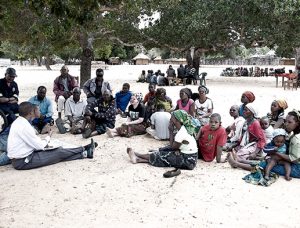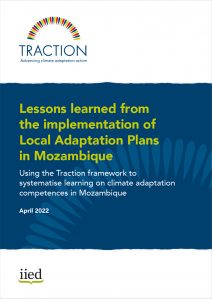Using the Traction framework to systematise lessons from a retrospective review of local adaptation
Who used the Traction Framework in Mozambique? Describe the partnership and where they are in their adaptation journey
The Traction framework was used by the authors of the original report “Lições aprendidas da implementação de planos locais de adaptação em Moçambique” including Prof Luis Artur of Eduardo Mondlane University in Mozambique with colleagues from IIED including Simon Anderson. These people had worked over a period of years on issues related to poverty-centred local adaptation.
Why did they think that using the Traction Framework would be helpful for them, what were their success criteria for using it?
Simon Anderson was part of the team that developed the Traction framework with partners in Sniffer. The idea of using the framework to systematise lessons from seven years of experience of local adaptation across Mozambique came up as a way to test the utility of the tool and to bring the Traction criteria into thinking in Mozambique on how local adaptation approaches can be developed further.
What were the key stages of the Traction process – what did you do?
The Traction framework is intended as a starting point for discussion and peer evaluation of adaptation enablers in different national and local contexts. In this work from Mozambique Traction has been used as a filter and analytical guide to systematise the results and findings of the local adaptation plans (LAP) evaluation.
Who led the process, who compiled the findings?
Luis Artur and Simon Anderson led the process and compiled the findings in the report.
What did you learn from applying the Traction Framework – what value did it add and what was the most helpful aspect?
From reflection on the Mozambican experience so far with LAP the following conclusions were identified, which are also summarised in the project report:
- LAP have been and continue to be a very useful tool for raising climate change awareness at local levels. The LAP have been and continue to be useful for the implementation of adaptation and mitigation projects in Mozambique
- There was initial enthusiasm and acceptance of LAP by both the government and cooperation partners, resulting in the generation of some 122 LAP across districts during the last 7 years. The expansive deployment of LAP methodology did not maintain the quality of final products. The initial model of LAP deployment was based on wider decentralization, multi-sectoriality and local dialogues. Over time this model has tended to become centralized and closed.
- Many innovations have emerged to the initial model for the design and implementation of LAP. These variants and the accompanying positive deviance has not been sufficiently captured by the oversight body of government. Reduced, over time, the dynamics and engagement of other actors. Three management models for planning and implementing LAP exist, namely controlled by the state, shared control between the state and partners, and fully controlled by the partner.
- Climate change factors and LAP are integrated in the local and provincial government’s annual planning mainly due to locally generated evidence on the occurrence of climate risks and increased awareness of climate related disasters. There has been an increase in the capacity of districts to make investment decisions for incremental adaptation actions, but at a larger scale, decision-making is still the preserve of agencies at provincial and central levels.
- Monitoring and evaluation of LAP performance has been weak and there is a disconnect between LAP and the national climate change strategy M&E system. The information collected through LAP monitoring then to be only on process indicators.
How will you use the findings from applying the Traction Framework to shape what you do in future?
The hope is that this systematisation of lessons will influence developments in the ways that local adaptation is supported in Mozambique.



